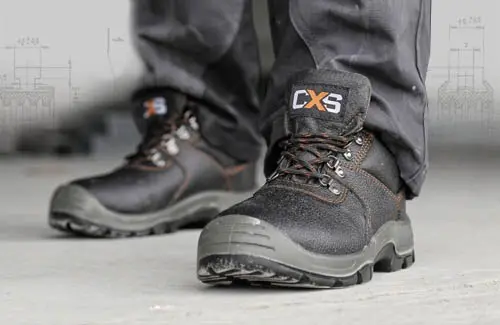The regular price is the current manufacturer's recommended price! FREE shipping for orders over EUR 41,67 within CZ+SK (PPLparcel)

They are divided into safety, work or protective footwear. For example, shoes marked with the initial letter "O" are certified according to the standard EN ISO 20347. These are shoes without a protective tip, which will only provide us with basic protection. This means against moisture, mechanical damage, dirt...
Safety shoes equipped with a protective toe are certified according to EN ISO 20345 and are marked with the letter "S". The toe protects the foot from compression of up to 15kN, or impact energy of up to 200 J which can be interpreted as compression by a weight of 1.5 tons, or as a fall of a weight of 20kg from a height of 1m.
Safety ("S"), protective ("P") and work footwear ("O") are divided into classes according to materials and other characteristics:
Class I: it is made of leather or other materials. However, this does not apply to all-plastic and all-rubber footwear.
Class II: the footwear is all-plastic or all-rubber.
Furthermore, the footwear is equipped with additional symbols and numbers indicate the degree of protection.
Protective shoes are also equipped with a protective toe, only with a lower level of protection than that of safety shoes. The toe protects the foot from impact energy up to 100 J (10 kg from a height of 1 m) and compression of up to 10 kN (compression by the weight of 1 ton). Protective footwear is certified according to the standard EN ISO 20346 and is marked with the letter "P".
For work shoes, it is the letter "O", as already mentioned. The material class remains the same.
OB - work shoes meet the basic characteristics (this means the requirement of the standard).
O1 - OB: has a closed heel, absorbs energy in this place and has antistatic properties.
O2 - O1: has resistance to moisture, penetration and absorption of water.
O3 - O2: the sole has a pattern / design and is puncture resistant.
O4 - OB: absorbs energy in the heel area and has antistatic properties.
Another criterion that you should pay attention to is the stability of the shoes on different types of surfaces. Anti-slip protection is marked with the abbreviations SRA, SRB or SRC. These indicate how well the footwear behaves on slippery surfaces.
SRA: These shoes are suitable for dry and wet surfaces with dirt.
SRB: This shoe is suitable for surfaces with slippery materials. For example, in an environment with fats or oils.
SRC: This shoe is suitable for almost any environment and provides the highest level of anti-slip.
How to choose the ideal work shoes?
There are several factors to consider that will influence the choice. Standards and degrees of protection. EN ISO 20347 (work shoes), EN ISO 20346 (protective shoes) or EN ISO 20345 (safety shoes). It is divided according to the protection provided by the footwear. Furthermore, it depends on the material and quality of construction, shape, size and, last but not least, the comfort and convenience that work shoes offer. After all, no one wants to run around scaffolding and have clogs on their feet :-)
Given that each employer determines the frequency of renewing work equipment (for example, footwear and work clothes) himself, it is not possible to set an exact deadline by law. However, they must ensure that they are replaced even before the expiration of their own set period, if the work aid loses its protective properties, or shows signs of wear or damage.
Each workplace requires specific footwear. Sometimes it is safety footwear that protects the foot, in other places the emphasis is on anti-static or anti-slip properties. Other times shoe covers are needed.
Work shoes are often equipped with reflective elements as another passive protection supplement.
The company NÁSTROJE CZ, s.r.o. offers a complete range of work shoes as well as their accessories.
Did you know that:
The oldest preserved shoe, made of leather, was recently found in an Armenian cave? Its age is estimated at 5500 years and it is made from a single piece of cowhide. Thanks to the integral lacing with a strap, it resembles a moccasin.

Other articles:
Jakými oděvy a pomůckami se při práci nejlépe chránit?
Jaké druhy klíčů známe?
Zástrčné klíče
Bezodskokové paličky a kladiva